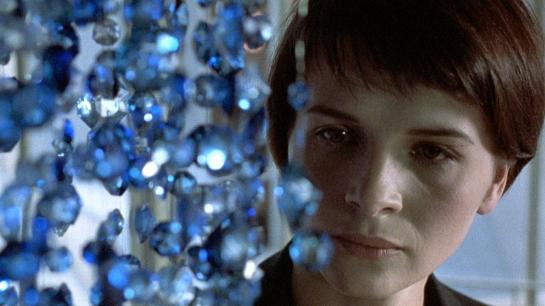
Krzysztof Kieślowski was at a pivotal point in his life while making his renowned Three Colors trilogy. He had determined that these would be his last movies and at the conclusion of his trilogy he announced it to the world. It was 1994 and Kieślowski was at the pinnacle of his career. Yet he stepped away from filmmaking with the intent of sitting at home and smoking while never ever visiting a cinema again. Sadly, Kieślowski would die two years later at the age 54. A true artist driven by his own creative rules right to the end.
Kieślowski’s Three Colors trilogy couldn’t be a better send off – a testament to a visionary’s passion for creating movies that burrow deep into the human elements that connect us. Kieślowski once said he preferred “touching on subject matters and situations which link people, and not those that divide people.” While he often spoke to the social and political climates of his times, they were too divisive and they were rarely his focus. He later said “Feelings are what link people together.” That very idea permeates ever frame of his Three Colors movies.
The trilogy’s name is taken from the three colors of the French flag – blue, white, and red. Each of the flag’s colors represent a particular ideal. Blue stands for liberty, white for equality, and red for fraternity. Each movie represents one of these ideals but on a human level and never within a political framework. Politics tend to divide and that was of no interest to Kieślowski. He sought to examine these principles within the confines of individual lives and all of the love, sorrow, pain, and humor that comes with living. These are feelings and emotions that we all know and can connect to. All three films, while able to stand on their own, do connect in subtle and sometimes surprising ways.

For much of the film it can be difficult to find the liberty in “Blue”, the first movie of Kieślowski’s Three Colors trilogy. In fact much of the film seems to be exploring a form of bondage – to grief, to pain, to the past. But I suppose it’s true what they say – liberty/freedom is much sweeter once you’ve tasted bondage. In “Blue” liberty as a theme is present, but much more as a desire than a reality.
The entire trilogy was written by Kieślowski and trusted collaborator Krzysztof Piesiewicz. Their first film focuses on a woman named Julie (played by the sublime Juliette Binoche) who is dealing with the death of her famous composer husband and young daughter from a car accident. Weighed down by the burden of her grief, Julie seeks to cut all ties with her past. She puts the family home up for sale, disconnects from the people they knew, and even destroys her husband’s final unfinished commissioned score. The only thing she keeps is her daughter’s sparkling blue mobile.
Julie wants to live as someone with no past. She rents an apartment in a corner of Paris with hopes of living in anonymity. But every unintended new human connection inevitably brings her closer to the past she is trying to escape. It’s here that Julie must decide whether to burrow deeper into her hole of isolation or unearth her sorrow and pain in hopes of breaking free from their hold on her. Kieślowski doesn’t make this an easy decision. It becomes even more complicated when secrets of her husband’s past surface.

The cinematography was handled by Sławomir Idziak who shot most of Kieślowski’s early work. As you can guess Idziak finds many ways to incorporate the color blue into his shots but they never feel meaningless. Like skillful craftsmen he and Kieślowski use the tones to great effect to accentuate feeling and highlight mood. It’s both beautiful and evocative. You will also notice a plethora of other crafty visual techniques that are constantly adding new perspective.
Kieślowski was all about examining human nature and no detail was too small or without meaning. “Blue” moves steadily and confidently, traits that are no doubt reflections of its director. It’s an intimate meditation centered by a bold, piercing performance from Binoche who speaks little but tells much through her revealing outward expression. As we observe the unfolding emotional layers of “Blue” we are given plenty to soak in. And it doesn’t take long before Kieślowski has us invested in his main character and the compelling themes finally brought to the surface most notably the aforementioned idea of liberty.
VERDICT – 4.5 STARS


This film is pretty much my favorite of the trilogy as I just love the look of it but also in how devastating it is in how it explores grief and how a woman uses it to liberate herself from the world.
I actually saw her grief as bondage. She was trying to liberate herself from it by throwing out her past. By living as a woman free of any past life. But liberty only came when she accepted that she could never flee from it. So much going on beneath the surface.
Nice review Keith. I’ve only started getting into Kieślowski the past couple of years and have seen The Double Life of Veronique of the first two parts of the Three Colors Trilogy. All are great, although while I do love Blue, I actually may prefer White over it. I know most people refer it to being the weak link in the series, but I think it’s an incredibly subversive and deep black comedy.
Yep, White is considered by many to be the weakest of the three films but I think it does the movie a disservice (more on it tomorrow). I first got into Kieslowski several years ago when I saw Camera Buff. Since then I’ve been really impressed with his work. The one big void for me is The Decalogue. I want to see it so bad but haven’t had the opportunity yet.
Been meaning to see Decalogue as well. I know Criterion just released a blu-ray edition of the series; I’m hoping to get my hands upon the collection soon.
It’s such an ambitious undertaking. But he wasn’t a filmmaker bothered with the conventional. I think that will always be one of his greatest qualities. Oh and Red…you definitely need to see it.
I swear I have a copy of this movie somewhere but have never watched it. Your review has given me the kick up the ass to see it, Keith.
Oh you should. I’ll be doing the other two films over the next two days. All are worth checking out.
I’m checking around to see if I do have it on DVD.
Fantastic! Let me know. These films were such an undertaking. Definitely highlights Kieslowski’s penchant for quality, thought-provoking cinema.
You’ll be the first to know what I make of these movies. I’m always on the lookout for something else to watch.
Aiyah… I really need to see this trilogy! I mean I ADORE miss Binoche. Thanks for the reminder, Keith 🙂
It’s so unique Ruth. Kieslowski does so much both narratively and visually to keep you thinking. I’ll be posting the review of the second film shortly.
I definitely will check out the trilogy at some point Keith.
P.S. Check your email, hope you wouldn’t mind being a guest for Dec Five for the Fifth 😉
Awesome. Would love to hear your thoughts on it. I posted my take on the second film of the trilogy today and will talk about the third tomorrow.
I saw your email and I remember doing it several months back. But I sure don’t mind doing it again if needed.
This a great review! I had no idea Kieslowski based these 3 on the French flag colors, having read so little of “Three Colors” on other sources. Juliette Binoche masters any role she’s given and Julie is surely no different. Would love to see Blue again now.
Thanks so much. Yep it was based on the flag but through Kieslowski’s own unique lens. I’m with you on Binoche. Easily one of the best working actresses. Actually I tried doing a list of the greatest actresses of all time and I’m pretty sure she cracked my top 10.
It would be interesting to see which other actresses you’d put on that list 🙂 But if I had a list, I would probably include her on my top 10 as well.
It was really tough to do. Check mine out when you get a chance. I’d love to hear your overall thoughts.
Awesome. Will check it out! 🙂
Of the three colors trilogy, I think Blue is the one I’m looking forward to the most because of Binoche. Great review!
She is sooooo good. I think you’ll have a blast diving into these things.